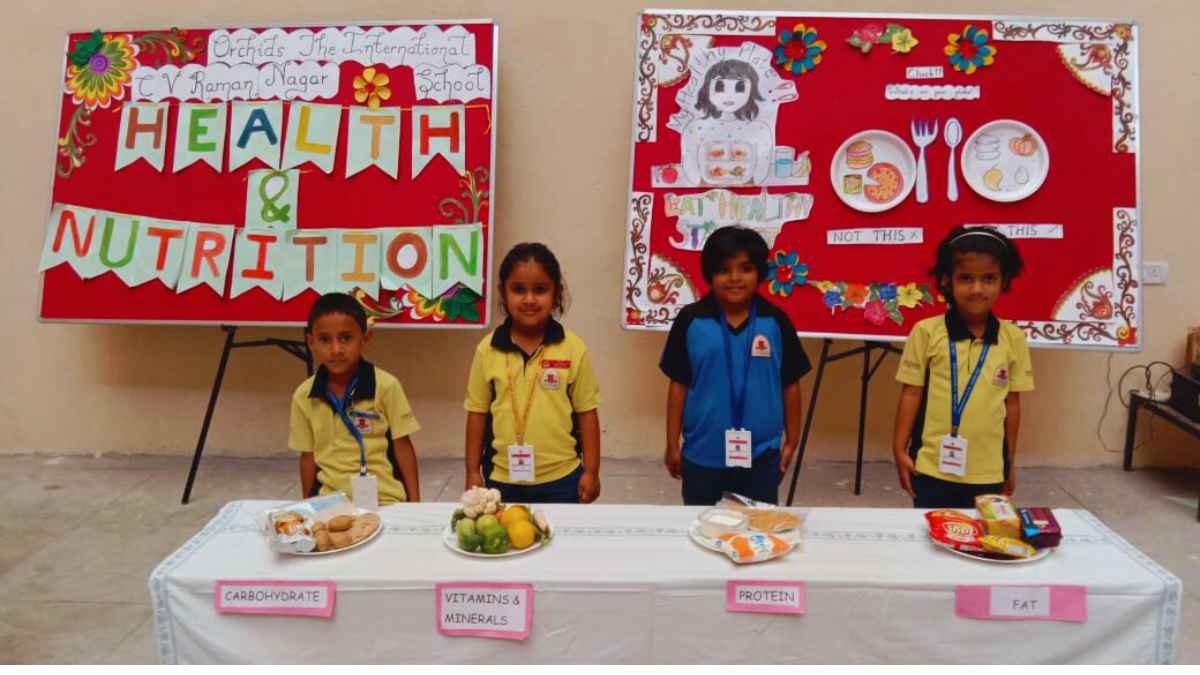Building Healthy Eating Habits
By Pinkey Sharma |
Date 06-08-2024

Table of Contents
Admissions Open for
Instilling good eating habits has today become an important attribute for children in their healthy living and development. Good nutrition supports physical growth, enhances mental development, and boosts immune function. Therefore, as parents, it becomes very important to instill such habits early in life for laying a base towards good health throughout life. This all-you-need guide is full of tested strategies and workable pointers for promoting good eating habits, introducing new foods to fussy eaters, and managing to increase their children's fruit and vegetable intake.
Importance of Healthy Eating Habits
Healthy eating habits are essential for children's growth, development, and long-term health. They provide the necessary nutrients to support physical activities, cognitive function, and immune system strength. By instilling these habits from an early age, parents can help prevent childhood obesity, reduce the risk of chronic diseases, and promote overall well-being.
Approaches parents can take to develop healthy eating habits in their children include:
Guide your family's choices rather than dictate foods: Make a wide selection of healthy foods available in your home. This exercise will teach your children how to make healthy eating choices. Leave unhealthy options like chips, soda, and juice at the grocery store. Serve water with your meals.
Encourage your children to eat slowly:
A child can detect hunger and fullness better when they eat slowly. Before offering a second helping or serving, ask your child to wait at least 15 minutes to see if they are truly still hungry. This will give the brain time to register fullness. Also, that second helping should be much smaller than the first. And if possible, load that second helping with more veggies.
Eat together as a family as much as possible:
Be sure to make mealtimes enjoyable with conversation and sharing, and not one of scolding or arguing. If the mealtimes are unpleasant, children may try eating faster so that they can leave the table ASAP. In this case, they will learn to associate eating with stress.
Engage your children in food shopping and meal preparation:
You will pick up clues on your children's liking or disliking of a particular food, have an opportunity to teach your children about nutrition, and provide feelings of accomplishment for your kids. More than this, children seem more willing to at least try, if not eat, foods that they help prepare.
Plan for snacks:
Continuous snacking might lead to overeating. On the other hand, planned snacks at regular times during the day could be part of a healthy diet and not spoil an appetite at mealtime. You should make snacks as nutritious as possible without depriving your children of occasional chips or cookies in parties or other social gatherings. Healthy food should be easily accessible and visible.
Set some family goals:
Maybe desserts should only be on the weekends, as would sodas. Water bottles should be empty at dinnertime to make sure one is hydrated.
Discourage eating meals or snacks while watching TV:
Instead, try to eat in only one part of your home—for example, in the dining room or kitchen. In front of the TV, it may be tough to pay attention to feelings of fullness, which can lead to overeating.
Help your children drink more water:
Over-consumption of sweetened drinks and sodas correlates with an increased rate of obesity in children.
Try not to use food to punish or reward your children:
Withholding food as a punishment may make children think that they won't get enough to eat. For example, because of acting up at the table you might have heard or told your children to go to bed without any dinner, which may make them think that they will go to bed hungry. Because of this, children are likely to end up eating whenever they get a chance. Similarly, if foods are used as a reward, then the child comes to think that these foods are somehow better or more valued than other types of food. For example, when dessert is offered if they eat their vegetables, it gives the wrong message about vegetables.
Keep your kids' food outside the home balanced:
Discussion in their school lunch program or sack their lunch and make sure that they have a variety. In addition, pick the healthier items while dining out.
Be mindful of the size of the serving and ingredients: Read food labels and limit foods with trans fat. Also, be sure you serve the appropriate portion as indicated on the label.
How Can Parents Encourage Children's Healthy Eating Habits?
Lead by Example:
Children learn and imitate their parents; therefore, as much as possible, make sure to have healthy eating habits and show them example foods, so they will probably be doing the same.
Show a Positive Environment Around Food:
Make meals enjoyable and not stressful at all. No food should also be rewarded or punished, but there should be a relaxed atmosphere where children are introduced to new foods without pressure.
Engage children in age-appropriate preparation of food and meal activities that teach them about various foods. By this method the child acquires the skills to make healthier choices.
Expose a child to various kinds of different foods, including fruits, vegetables, whole grains, lean proteins, and dairy food products. Offer new foods several times as tastes change over time.
Establish regular times for meals:
A schedule helps children develop good eating habits. Offer food at regular times each day to keep energy levels up and to prevent overeating.
Nutrition education:
Educate children regarding the reason for various food groups and how they interact in the body to allow growth and development to occur in a healthy manner. Balanced nutrition can be taught using age-appropriate materials.
Limit Sugary and Processed Foods:
It does not prevent occasional treats from being taken at all, but whole foods should have priority over sugary snacks and processed foods that are high in fat and other unhealthy additives similar to medicines.
Strategies to Introduce New Foods to Picky Eaters
-
Start Slow: Introduce new food groups or servings in small portions with familiar favorites. Allow them to explore new flavors at their own pace.
-
Make It Fun: Make the experience of having new foods positive. Use creative presentations—like arranging foods into fun shapes or using colorful plates—to make meals more appealing to the eyes.
-
Offer choices: Engage children in the choice of foods. Let them select from a range of healthy choices of their own accord, what they will try. This empowers the child and often encourages them to become risk-takers in food choice.
-
Be Patient: Sometimes, it may take up to ten or more tries before a child first starts to like a new food. Never force or bribe a child to eat as this can put negative associations with food.
-
Mix New Foods with Familiar Foods: Mix new foods into recipes your child already loves. For instance, mix veggies into the pasta sauce or puree fruits into smoothies to ease exposure of a child to new flavors and foods.

How Can Families Incorporate More Fruits and Vegetables into Kids' Diets?
-
Mix and have some of every kind on hand: Always have some fresh, frozen, and canned fruits and veggies available to ensure that there will always be a healthy option accessible.
-
Keep Fruits and Veggies on Hand: Wash, chop, and prepare fruits and veggies in advance to make quick snacks. Store them in visible places in the fridge or on counters.
-
Include some fruits and vegetables at every meal: Add them to salads, sandwiches, wraps, and main dishes to increase their intake throughout a day.
-
Outrageous Snacks: Serve fruits and vegetables for snacks between meals. Try pairing them with dips, like hummus or yogurt, to make them more interesting and tasty.
-
Get Creative with Recipes: Experiment with different methods of cooking and recipes that can make fruits and vegetables much more appealing for kids. They could be baked, grilled, roasted, or blended into smoothies and sauces.
How to Promote Healthy Eating Habits at School?
Does the school your kid goes to really matter when it comes to the grade he gets on food choices? You bet! Your child spends a big part of his day in school. They should learn about healthy eating at school and then practice it in real life.
A role for parents and caregivers, too. They can support changes already underway, or advocate for healthier changes by starting—or joining—a nutrition committee, or by suggesting non-food items to be sold at fundraisers. Collaboration between parents, caregivers, teachers, and schools fosters a school nutrition environment in which healthy choices are the easy choice.
Ways in which schools can promote a nutritious eating environment
Children acquire knowledge more effectively when they receive proper nutrition. Eating properly can enhance children's memory and focus. Furthermore, maintaining a nutritious diet promotes proper growth and development. This is why it is crucial for children to have the opportunity to make healthy food choices while at school.
Which of these healthy practices does your child’s school encourage?
- Provide items like pencils, stickers, or additional playtime as incentives or awards instead of giving out food with limited nutritional benefits.
- Make sure educators receive training in nutrition education and are knowledgeable about promoting healthy body image.
- Teachers should be reminded that they play a crucial role in setting an example for healthy eating practices.
- Provide healthy food options for classroom celebrations, special occasions, designated lunch days, vending machines, and school cafeterias.
- Allow a minimum of 20 minutes for lunch for eating and socializing.
- Offer culturally suitable and healthy food options for nutrition programs.
- Consider using non-edible items for fundraising events instead of depending on bake sales or selling unhealthy food options.
- Permit children to have a water bottle on their desk for staying hydrated when they are thirsty.
- School-wide nutrition policy that establishes the school’s beliefs and dedication to promoting a healthy eating environment in school.
- Incorporate food-related skills into the school curriculum, such as reading labels, preparing meals, cultivating plants, and buying groceries.
- Engaging with farmers to understand the process of food production.
Conclusion
Building healthy eating habits in children requires a lot of patience, creativity, and time. By providing an enabling environment, offering healthy choices, and engaging them in food activities, parents can empower children towards making positive food choices for lifelong health and well-being.
In essence, raising healthy eaters means more than just providing good food; it truly means nourishing honest relationships with food and raising future values needed to sustain health. Every small step toward raising healthier eating habits depicts a healthy future of our children where they will thrive to their utmost advantage.
FAQ
What are 10 healthy eating habits?
These are some healthy eating habits:
-
Eat a good breakfast
-
If you eat fast food, choose wisely.
-
Keep healthy snacks on hand.
-
Eat plenty of foods rich in calcium.
-
If you need to lose weight, do it sensibly.
-
Limit your sugar intake
-
Visit the dining hall salad bar.
-
Limit your soft drink intake
-
Drink lots of water
-
Enjoy your food.
How to develop healthy eating habits?
Choose foods and beverages from all food groups — vegetables, fruits, grains, dairy, and proteins — not just 1 or 2 of them. Eat a mix of foods within each food group. For example, each week try eating several types of vegetables, including dark green, red and orange, starchy ones, legumes, and others.
How to build a healthy meal?
Break your meal into parts. Think of your plate like it has 4 parts: 1 part for whole grain foods, 2 parts for vegetables and fruits, and 1 part for proteins. With this method,half your plate will include vegetables and fruits. Make whole grain foods the base.
Liked what you read? Feel free to share this article with your friends and spread the knowledge!
Related Blogs
Common Nutritional Concerns for Kids: Identify common nutritional issues in kids and get tips.
Physical Activity and Exercise for Kids: Explore various fun physical activities and exercises for kids to boost their health, fitness, and overall well-being.
CBSE Schools In Popular Cities
- CBSE Schools in Bangalore
- CBSE Schools in Mumbai
- CBSE Schools in Pune
- CBSE Schools in Hyderabad
- CBSE Schools in Chennai
- CBSE Schools in Gurgaon
- CBSE Schools in Kolkata
- CBSE Schools in Indore
- CBSE Schools in Sonipat
- CBSE Schools in Delhi
- CBSE Schools in Rohtak
- CBSE Schools in Bhopal
- CBSE Schools in Aurangabad
- CBSE Schools in Jabalpur
- CBSE Schools in Jaipur
- CBSE Schools in Jodhpur
- CBSE Schools in Nagpur
- CBSE Schools in Ahmednagar
- CBSE School In Tumkur

Call Us to know more about Orchids
Swipe Up



.jpg&w=1920&q=80)













